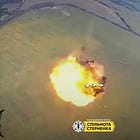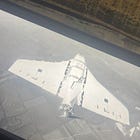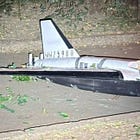Interception Video Reveals Installation Of Multiple Cameras On Russian Gerbera Decoy Drone
🇷🇺 🇺🇦 Analysis
A new video recorded by what appears to have been a Ukrainian multirotor interceptor drone reveals the installation of multiple electro-optical sensors/cameras—seemingly of the consumer-grade security camera variety—mounted on the topside of the fuselage of a Russian Gerbera propeller-driven fixed-wing decoy drone. The Gerbera is understood to be primarily employed in an unarmed configuration alongside Russia’s Shahed-136/Geran-2/Garpiya propeller-driven fixed-wing strike drones.
One of the countermeasures that Russia has pursued in response to Ukraine’s increasingly regular and widespread employment of interceptor drones of both the multirotor and fixed-wing variety—a practice that is understood to have begun around near the end of summer 2024—has been to install a rearward-facing camera on fixed-wing drones of various types, some of which would would not ordinarily feature any onboard electro-optical sensor at all. When installed alongside a suitable onboard computer to process the sensor feed, Russian fixed-wing drones can perform pseudo-random evasive maneuvers as a Ukrainian interceptor drone approaches. This greatly increases the challenges encountered by the Ukrainian air defence operators attempting to intercept Russian drones in a context in which most, if not all, of Ukraine’s interceptor drones of both the multirotor and the fixed-wing variety appear to be remotely piloted human-in-the-loop uncrewed aircraft turned anti-aircraft munitions. It bears emphasis that Ukraine’s interceptor drones of both the multicopter and fixed-wing variety are electrically powered designs. The onboard battery offers very limited range-endurance, not least when the interceptor drone must typically fly much faster than the target Russian fixed-wing drone to be able to intercept it. The initiation of pseudo-random evasive maneuvers can, therefore, allow a Russian fixed-wing drone to evade interception by Ukrainian interceptor drones, at least until it runs into the detection and engagement range of another Ukrainian interceptor drone unit that may be able to pull off a successful interception attempt.
Russia is known to have also equipped some of its uncrewed aircraft with simple passive radio frequency sensors that, upon detecting a strong signal in a frequency range associated with Ukrainian interceptor drones, initiate pseudo-random evasive maneuvers. This approach does not require the use of fairly inexpensive commercial-off-the-shelf electro-optical sensors/cameras and an onboard computer. This passive radio frequency approach can also work at night and in low light conditions—commercial-off-the-shelf infrared-band sensors exist and are widely installed on armed “first-person video” (“FPV”) multirotor drones in the Russia-Ukraine War, but are more expensive.
The new video highlights a different non-exclusive approach that Russia is now experimenting with, if not pursuing for widespread deployment. The commercial-grade electro-optical sensors mounted on the Gerbera decoy drone in the above video are notably installed on the topside of the fuselage so as to detect Ukrainian interceptor drones that are not merely in (“tail-chasing”) pursuit of the Gerbera but on a higher altitude interception course that will end in a dive toward the Gerbera. While there are videos documenting interceptions in which Ukrainian interceptor drones impact the underside of a Russian fixed-wing drone or the rear section (i.e., targeting the propeller, which is the obvious target when unarmed kinetic-impact only interceptor drones are used), it is generally preferable for the interceptor drone to attempt to attack the topside of the fuselage, given that the wings have a larger surface area than the fuselage, let alone the rear aspect. All else being equal, a top attack profile is also more energy efficient.
It goes without saying that the above video does not record the dual sensor-equipped Russian Gerbera decoy drone undertaking pseudo-random evasive maneuvers as the Ukrainian interceptor drone approaches. It is not clear why this appears to have been the case. It is also not clear whether this particular Gerbera specimen also featured one or more electro-optical sensors on the underside of the fuselage, which can, in principle, be used to offer something in the vein of omnidirectional warning on impending interception by a fairly slow Ukrainian interceptor drone of either the multirotor or fixed-wing variety. It is worth noting that the passive radio frequency sensor approach, the effectiveness of which is inherently affected by the usual wartime evolution of radio datalink technology, constitutes another way of offering omnidirectional warning of an impending interception by a Ukrainian interceptor drone. The passive radio frequency sensor approach will, however, only work for as long as Ukrainian interceptor drones are primarily, if not exclusively, human-in-the-loop uncrewed aircraft turned anti-aircraft munitions. It bears emphasis that there are indications that this may change going forward.
As of this writing, documentary evidence exists in the public domain for Russia’s installation of electro-optical seekers to initiate pseudo-random evasive maneuvers on its fixed-wing ISR drones, which are typically used within several dozen kilometers of the frontlines/international border, and its Gerbera decoy drones, which regularly penetrate several hundred kilometers of Ukrainian-controlled airspace. Ukrainian sources report that Russia has been working on installing electro-optical sensors and/or passive radio frequency sensors on its Shahed-136/Geran-2/Garpiya strike drones so that these can also undertake pseudo-random evasive maneuvers when subject to an interception attempt by a Ukrainian interceptor drone of either the multirotor or fixed-wing variety. While public documentary evidence of this is not available at this time, such approaches are likely to result in a situation in which propeller-driven fixed-wing strike drones such as the Shahed-136/Geran-2/Garpiya remain viable as fairly inexpensive strike munitions amid Ukraine’s increasingly widespread use of increasingly more capable uncrewed aircraft turned anti-aircraft munitions. As with so many aspects of the Russia-Ukraine War, an intense measure-countermeasure competition is underway, and nothing that we have seen to date is likely to have been the last act either in the specific context of that conflict or elsewhere in the world.
Some relevant recent posts:




